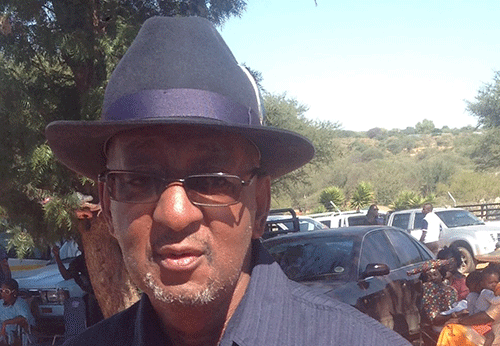Kae Matundu-Tjiparuro
What may the years 1863 and 1923, and now 2023 have in common? The obvious, quick and easy guess is that they end with the odd number three.
Yes?
Indeed.
But does the odd number three politically, culturally and spiritually has any meaning ominously or otherwise like the number 13 may have to the English when it falls on a Friday, spelling bad luck.
Not as far as I know.
But to cut a long story short, the three years relates to Ovaherero history positively and progressively. Starting and going back to 1863 when the Ovaherero converged in Otjimbingue and elected in the persona of Samuel Maharero as their Commander-In-Chief in the war of resistance against Imperial Germany. Culminating on 2 October 1904, in the Extermination Order against the Ovaherero.
Eventually forcing Samuel Maharero escaping Imperial Germany’s military might with some of his people into exile with many succumbing in the harsh Kalahari Desert enroute to the then British Protectorate of Bechuanaland, today’s Republic of Botswana.
Where Samuel Maharero died in 1923, initially interned in Serowe, home of the Bamagwato throne. For his remains to be exhumed the same year, 1923, for reburial in Okahandja, on 26 August. Hence, the significance of 26 August, which today in an independent Namibia, has been re-named Heroes and Heroines’ Day. But which all along since 1923 with the reburial of Samuel Maharero, was and had been known as Red Flag Day, Okahandja Day and/or Herero Day, due to the heroics of the Ovaherero and Ovambanderu under a united military command structure of Samuel Maharero against German colonialism.
That 26 August was to and has become in an independent Namibia Heroes/Heroines’ Day is nothing unbecoming, at least on the face of it.
Because there’s no delinking the resistance wars against German Imperialism as led by the founding fathers of Namibian nationalism like Samuel Maharero, Kahimemua Nguvauva, Hendrik Witbooi, Abraham Christian, Abraham Morris, and many others with the latter day torchbearers of the liberation struggle. Who must have taken on the baton from the likes of Chief Hosea Kutako, himself a survivor of the war of resistance against German Imperialism.
Specifically, a survivor of the infamous extermination order against his people.
The year 1923 is not significant only for the repatriation from Botswana of the remains of Samuel Maharero and their reburial in Okahandja. The occasion offered the Ovaherero the opportunity for remobilisation and regrouping, politically and otherwise. Especially culturally and spiritually when after the 1923 pilgrim for the reburial of Samuel Maharero, imbued with ancestral spirits through reconnection with Samuel Maharero via his reburial, they dispersed all over the territory to seriously rekindle their cultural and spiritual being, that centred before colonialism around the holy fire (okuruwo). But which was destroyed by the emergence of colonialism, and its opium of Christianity.
The annual pilgrim to Okahandja by the Ovaherero instituted by the decree of Kutako in 1923, this year, 2023, also sees and coincides with the centenary commemoration of the repatriation and reburial of the remains of Samuel Maharero. Hence, its prima facie significance given the symbol of Ovaherero history, and their subsequent genocide, that Samuel Maharero, had come to be. But with the precedent already set by the years 1863 and 1923, as explained already as exemplified by the respective milestones, it is left to the various current leaders of the Ovaherero and Ovambanderu to not only converge in unison in Okahandja this weekend but to make the year 2023 a historic and momentous one akin to the previous two of 1863 and 1923.
Otherwise, the memory of Samuel Maharero centenary cannot be more than akin to the desecration of his grave in Okahandja. Surely, the Ovaherero and Ovambanderu cannot but judge their leaders according to what they can reap from what they have sown.
This weekend they must somehow use the pilgrim for some rekindling. This time for the arduous mission weighing heavily on their shoulders, which is the genocide of their forebears and atonement by the government of the Federal Republic of Germany.
But if such a rekindling may prove a mammoth undertaking for them, joining the pilgrim to simply pay homage to Samuel Maharero for his heroic exploits, and especially for not surrendering and/or compromising his people with treaties, is not much asking. Needless to say these leaders are much aware that Samuel Maharero and other leaders bequeathed them and their people a rich and proud legacy. But a legacy that as yet must be taken to its logical conclusion.
The beginning towards this historic mission cannot be some times in the future but now with the centenary commemoration when they must start to plant the seed of common purposefulness. To stand together as one people in meeting head on whatever challenges confront their communities because such challenges are common to all of their communities and peoples and should be the ties that bind them.
This is nothing but the memory of Samuel Maharero and that he left them unfinished business, especially with the government of the Federal Republic of Namibia. This is what history and their people will judge them. Not tomorrow, the day after but today.
Straightaway from this weekend’s centenary commemoration.


